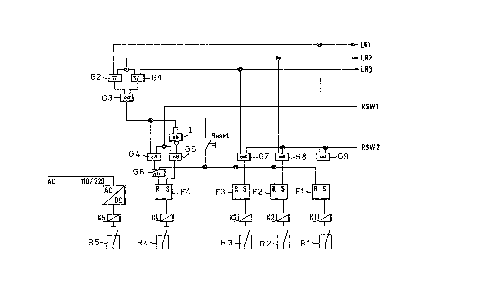Some of the information on this Web page has been provided by external sources. The Government of Canada is not responsible for the accuracy, reliability or currency of the information supplied by external sources. Users wishing to rely upon this information should consult directly with the source of the information. Content provided by external sources is not subject to official languages, privacy and accessibility requirements.
Any discrepancies in the text and image of the Claims and Abstract are due to differing posting times. Text of the Claims and Abstract are posted:
| (12) Patent: | (11) CA 2038063 |
|---|---|
| (54) English Title: | MONITORING SYSTEM FOR STEP-TYPE SWITCHING TRANSFORMER |
| (54) French Title: | SYSTEME DE SURVEILLANCE POUR TRANSFORMATEUR DE COMMUTATION A GRADINS |
| Status: | Expired and beyond the Period of Reversal |
| (51) International Patent Classification (IPC): |
|
|---|---|
| (72) Inventors : |
|
| (73) Owners : |
|
| (71) Applicants : |
|
| (74) Agent: | NORTON ROSE FULBRIGHT CANADA LLP/S.E.N.C.R.L., S.R.L. |
| (74) Associate agent: | |
| (45) Issued: | 1999-12-07 |
| (22) Filed Date: | 1991-03-12 |
| (41) Open to Public Inspection: | 1991-09-22 |
| Examination requested: | 1997-02-10 |
| Availability of licence: | N/A |
| Dedicated to the Public: | N/A |
| (25) Language of filing: | English |
| Patent Cooperation Treaty (PCT): | No |
|---|
| (30) Application Priority Data: | ||||||
|---|---|---|---|---|---|---|
|
A multiphase stepping transformer wherein a closed vacuum
interrupter at each phase is opened before a respective stepping
switch is advanced is controlled by continuously monitoring current
flow through the interrupters. Before the interrupters are opened an
error signal is generated unless all of the monitored current flows
lie to one side of a predetermined threshold. After the interrupters
are opened an error signal is generated if current flow is detected
through any of the interrupters. Advance of the stepping switches is
blocked on generation of any error signal. The apparatus includes for
each interrupter a respective current detector, a light-emitting diode
energized by the respective detector, a light receiver associated with
each diode, and a light-transmitting cable connecting each diode with
the respective receiver.
Note: Claims are shown in the official language in which they were submitted.
Note: Descriptions are shown in the official language in which they were submitted.

2024-08-01:As part of the Next Generation Patents (NGP) transition, the Canadian Patents Database (CPD) now contains a more detailed Event History, which replicates the Event Log of our new back-office solution.
Please note that "Inactive:" events refers to events no longer in use in our new back-office solution.
For a clearer understanding of the status of the application/patent presented on this page, the site Disclaimer , as well as the definitions for Patent , Event History , Maintenance Fee and Payment History should be consulted.
| Description | Date |
|---|---|
| Inactive: Reversal of expired status | 2012-12-02 |
| Time Limit for Reversal Expired | 2011-03-12 |
| Letter Sent | 2010-03-12 |
| Inactive: IPC from MCD | 2006-03-11 |
| Grant by Issuance | 1999-12-07 |
| Inactive: Cover page published | 1999-12-06 |
| Pre-grant | 1999-09-03 |
| Inactive: Final fee received | 1999-09-03 |
| Notice of Allowance is Issued | 1999-07-29 |
| Letter Sent | 1999-07-29 |
| Notice of Allowance is Issued | 1999-07-29 |
| Inactive: Approved for allowance (AFA) | 1999-06-29 |
| Inactive: Adhoc Request Documented | 1998-12-15 |
| Inactive: IPC removed | 1998-12-09 |
| Inactive: First IPC assigned | 1998-12-09 |
| Inactive: IPC assigned | 1998-12-09 |
| Inactive: Single transfer | 1998-10-09 |
| Inactive: Status info is complete as of Log entry date | 1997-11-25 |
| Amendment Received - Voluntary Amendment | 1997-11-25 |
| Inactive: Application prosecuted on TS as of Log entry date | 1997-11-25 |
| All Requirements for Examination Determined Compliant | 1997-02-10 |
| Request for Examination Requirements Determined Compliant | 1997-02-10 |
| Application Published (Open to Public Inspection) | 1991-09-22 |
There is no abandonment history.
The last payment was received on 1999-11-16
Note : If the full payment has not been received on or before the date indicated, a further fee may be required which may be one of the following
Patent fees are adjusted on the 1st of January every year. The amounts above are the current amounts if received by December 31 of the current year.
Please refer to the CIPO
Patent Fees
web page to see all current fee amounts.
| Fee Type | Anniversary Year | Due Date | Paid Date |
|---|---|---|---|
| Request for examination - standard | 1997-02-10 | ||
| MF (application, 7th anniv.) - standard | 07 | 1998-03-12 | 1998-03-09 |
| MF (application, 8th anniv.) - standard | 08 | 1999-03-12 | 1999-01-12 |
| Final fee - standard | 1999-09-03 | ||
| MF (application, 9th anniv.) - standard | 09 | 2000-03-13 | 1999-11-16 |
| MF (patent, 10th anniv.) - standard | 2001-03-12 | 2001-01-11 | |
| MF (patent, 11th anniv.) - standard | 2002-03-12 | 2001-12-18 | |
| MF (patent, 12th anniv.) - standard | 2003-03-12 | 2003-01-21 | |
| MF (patent, 13th anniv.) - standard | 2004-03-12 | 2004-01-21 | |
| MF (patent, 14th anniv.) - standard | 2005-03-14 | 2004-12-22 | |
| MF (patent, 15th anniv.) - standard | 2006-03-13 | 2006-01-23 | |
| MF (patent, 16th anniv.) - standard | 2007-03-12 | 2007-02-16 | |
| MF (patent, 17th anniv.) - standard | 2008-03-12 | 2008-02-25 | |
| MF (patent, 18th anniv.) - standard | 2009-03-12 | 2009-02-12 |
Note: Records showing the ownership history in alphabetical order.
| Current Owners on Record |
|---|
| MASCHINENFABRIK REINHAUSEN GMBH |
| Past Owners on Record |
|---|
| DIETER DOHNAL |
| KURT KUGLER |